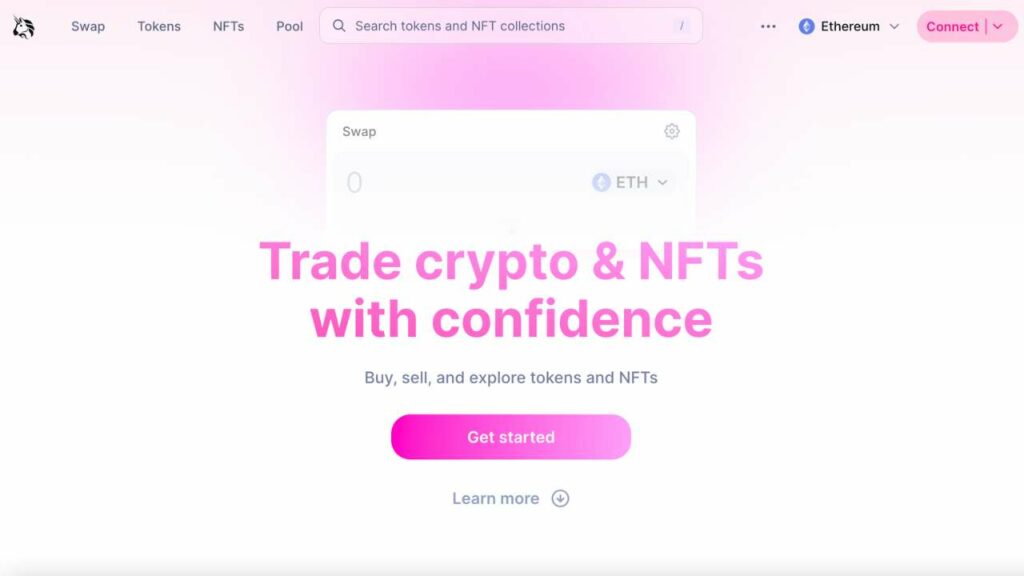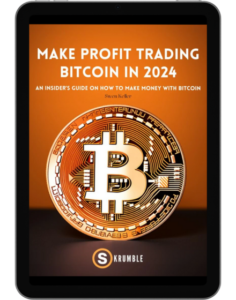What is Uniswap (UNI)?
Swen Keller
- Home
- /
- Cryptocurrencies
- /
- What is Uniswap (UNI)?
Swen Keller
What is Uniswap (UNI)?
Uniswap is a cryptocurrency and decentralized exchange protocol that facilitates automated transactions allowing users to trade Ethereum tokens via peer-to-peer transactions. The Uniswap protocol runs on Ethereum and is governed by holders of its native token UNI. Uniswap is also an open-source blockchain.
Who is the Founder of Uniswap?
Uniswap was founded by Hayden Adams on the 2nd of November 2018. Before founding Uniswap Hayden Adams was a mechanical engineer at Siemens.
How Does Uniswap Work?

The Uniswap platform uses blockchain smart contracts to support decentralized cryptocurrency trading of all supported assets. Using Uniswap’s liquidity pools, traders swap pairs of digital assets.
These pools utilize smart contracts to facilitate automated rebalance after a transaction. The operation of the Uniswap protocol works like an electronic ledger, which is constantly updated to display all transactions happening between users on the Uniswap platform. It functions as an automated market maker (AMM). Here’s what AMM means.
That said because Uniswap is a decentralized exchange it does not request permission for users to gain access. The Uniswap platform is free for all and does not restrict the access of potential users. It is open to anyone who intends to create a market to swap tokens, trade assets, or provide liquidity.
Users who hold the UNI token can also participate in Uniswap governance with voting power shared in accordance with the amount of UNI tokens each user holds.
Uniswap blockchain uses the Proof of Work mechanism as it operates on the Ethereum blockchain which functions on the same. However, Ethereum is transitioning to the more sustainable Proof of Stake Consensus mechanism, which unlike PoW does not demand the use of vast energy and computing resources.
Concerning participation in the Uniswap network, users would need to connect a compatible wallet and hold Ether as the Ethereum blockchain on which Uniswap operates collects fees for facilitating transactions. And users must pay incurred fees in Ether.
Key Features of Uniswap
Uniswap Liquidity Pool

A liquidity pool is a group of tokens locked in a smart contract that is used for trading between assets on a decentralized exchange. Unlike in traditional finance and with an centralized exchange where liquidity is organized using a central limit order book where sellers and buyers trade by organized price and demand, some decentralized exchanges like Uniswap use an Automated Market Marker to determine the price of two assets.
The Automated Market Maker( AMM) prices assets with a pricing algorithm. The “x*y=k” formula is used for the pricing of assets. X represents the amount of one token in the liquidity pool, y represents the amount of the other asset in the pool and k is a fixed constant. Using the AMM and the formula above, the value of both assets always remains at a 50:50 ratio.
The pooled tokens in the Uniswap Liquidity pool are provided by Liquidity Providers (LP). Liquidity providers are rewarded with the LP token in exchange for providing liquidity to the Uniswap protocol. Uniswap Liquidity providers, provide ERC-20 tokens to the protocol liquidity pools. The larger the size of the pool, the better the proving and the higher the volume of trades.
There are 4 different types of liquidity providers in Uniswap’s Liquidity Pool. They are:
- Professional LPs: These liquidity providers use market making as their major strategy. They also develop ways and tools for tracking their liquidity position across different projects.
- Passive LPs: These are liquidity providers that invest their crypto assets in order to accumulate trading fees and generate passive income.
- Token Projects: These choose to become Liquidity providers to create a liquid market for their tokens. This makes it easy for users to buy and sell tokens.
- DeFi Pioneers: This is made of LPs that wish to explore complex liquidity provision interactions like liquidity as collateral, incentivized liquidity, and other experimental strategies.
Users who wish to provide liquidity on Uniswap V2 are required to do so across the entire price curve from 0 to infinity. While Uniswap v3 allows LPs to optionally concentrate capital in the custom price range they can generate the highest return in.
Weaknesses of Uniswap
One of the major weaknesses of Uniswap is that users cannot buy cryptocurrencies using fiat money on the platform. For crypto to be purchased, you must already have crypto in your crypto wallet that is connected to the exchange. Since it is a decentralized exchange, to use Uniswap, you will first need to buy crypto somewhere else.
Uniswap also has the problem of high gas fees. Since the Uniswap platform is built on Ethereum, its gas fees are dependent on how busy the Ethereum network is. If the network is congested, the gas fee increases. Since Ethereum is often congested, Uniswap network fees are costly.
As a decentralized exchange, the Uniswap platform has no KYC. This is because users do not need to create an account to use the exchange. While this is good for investors that want to trade anonymously, it is also a red flag for regulators. Exchanges without KYC often come under regulatory scrutiny and Uniswap has gotten its fair share of such scrutiny. In 2021, the SEC launched an investigation of Uniswap. While there haven’t been any legal issues, the exchange is still under the radar and could be picked on at any time by the government and tax authorities.
Another weakness of the Uniswap platform is the risk of impermanent loss faced by Liquidity Providers. The value of the crypto can change from the time the Liquidity Provider deposited it in the liquidity pool. If the cryptocurrency is highly volatile, the LP may lose money if the price of the cryptocurrency dips.
Also, unlike other Automated Market Makers like PancakeSwap and Sushi swap, Uniswap does not provide APRs for liquidity pools, which makes it difficult for providers to know which liquidity pool pays the most.
Finally, the UNI token is solely a governance token within the Uniswap ecosystem. It currently does not have any real-world value. This could affect the value of the token soon.
How is Uniswap (UNI) Created?
Uniswap (UNI) is minted through liquidity mining. One billion UNI tokens have already been minted at its launch of which 60% of them were distributed to Uniswap community members. The other 40% is to be distributed to advisors, investors, and team members in 4 years. The major part of this distribution occurs through liquidity mining.
Mining Uniswap (UNI)
As already mentioned, the UNI token is mined via liquidity mining. This type of mining means that UNI tokens are distributed to users who provide liquidity to these Uniswap pools:
- ETH/USDT
- ETH/WBTC
- ETH/DAI
- ETH/USDC
How does it work? Uniswap community members are crypto investors who have used an Ethereum address to interact with Uniswap smart contracts. To claim UNI tokens via liquidity mining head to app.uniswap.org, and connect the Ethereum wallet you used Uniswap with. Next, click “Claim your UNI tokens. That’s it.
Which Blockchain does Uniswap Use?
Uniswap uses the Ethereum blockchain.
How to Use Uniswap (UNI)?

UNI is the governance token of the Uniswap ecosystem. The token was launched in September 2020 through a retrospective airdrop for users who have provided liquidity or swapped tokens on the protocol. UNI holders can take part in Uniswap governance and vote on important decisions concerning the protocol like future upgrades and how the funds in the treasury should be used. UNI holders can also bind their tokens to an address and delegate their voting power to themselves or someone else.
UNI can be staked through liquidity staking to generate income for the token holder. Holders can also have more control of their money through UNI because the token can serve as an alternative, decentralized payment method.
How to Buy Uniswap (UNI)?

UNI can be purchased with fiat currency on centralized exchanges like Gemini, Kraken, and Coinbase. The token can also be traded with other trading pairs (usually Tether) on exchanges like Huobi Global, Binance.Us, and Kucoin. On centralized exchanges like DigiFinex, Binance, and BingX Uniswap is traded with popular trading pairs like UNI/CAD, UNI/USD, UNI/GBP, UNI/PHP, UNI/AUD, and UNI/INR.
To buy UNI, you will need to create an account in a crypto exchange and fund your account. To buy the token, go to the trading platform in the exchange and type in the ticker symbol “UNI”. Enter how many UNI tokens you wish to buy and confirm your order.
How to Store Uniswap (UNI)?
UNI tokens can be stored in both hardware and software wallets. Digital wallets like Guarda wallet, Binance Wallet, Trust Wallet, Metamask, Zengo, Coinbase Wallet, Atomic Wallet, ImToken, Ledger Nano S, and Trezor hardware wallets all support the storage of UNI.
You should store your assets in a hardware wallet as hardware wallets are more secure than online or software wallets. Hardware wallets are best for storing a large number of cryptocurrencies. If however you trade often and want your UNI tokens in a software wallet you can easily access, you should choose one with good security and insurance.
Best Place to Stake (UNI) Uniswap?
Users can earn UNI tokens by staking their assets in Uniswap’s liquidity pools. This process of earning rewards from staking in liquidity pools is called liquidity mining or yield farming.
What You Need to Know About the Future of Uniswap?
The future of the Uniswap token is related to its price value and several factors directly impact the value of the Uniswap token. These include the current crypto news, exchange inflows and outflows, the general economic environment, and technical development. The price of the token is also influenced by the demand for it by users of the network. So how the token fares in the future is dependent on the positive outcome of the various factors that impact its value.
Conclusion: Should You Put Your Money in Uniswap?
If you believe that more users will use the Uniswap platform and future updates will positively affect trader perception about the protocol then investing in Uniswap may be a great idea.
Risk in Investing in Uniswap
Uniswap (UNI) is a volatile asset and you can lose all investment in bad market situations. So only invest money you’re willing to lose.
FAQ
Most frequent questions and answers
You can earn UNI tokens by staking them in the platform’s liquidity pools. This process is called yield farming or liquidity mining. So the distribution of UNI tokens happens through liquidity mining pools, not the traditional mining like with Bitcoin. Here’s how this process works. Decentralized exchanges like Uniswap require liquidity to function but users holding tokens are the liquidity providers to the exchange. The exchange then rewards users who facilitate the operation of their capital. Simply put, by locking your funds in a decentralized platform you contribute to their operation, and in exchange, they give you commission rewards on one or more tokens.
Yes, Uniswap is staked through liquidity staking or yield farming.
The total amount of UNI tokens to be minted is 1 billion tokens. Currently, there are about 720 million units in circulation which are 72% of the total number of units.
Uniswap is a decentralized protocol. This means that the exchange does not generate revenue as all transaction fees are user-controlled and received by traders responsible for providing liquidity. At the moment, the transaction fee paid to liquidity providers is dependent on a 3-step system of 1%, 0.3%, and 0.05% based on the tier that provides the best deal for trades. The transaction fees are added to the liquidity pool on default, however, providers can redeem them at will.
That said, it is unclear if Uniswap takes a percentage of the transaction fees but the like option is that it has reserves of the UNI governance token and sells it periodically to cover expenses and maintenance.
Yes, UNI is the governance and utility token of the Uniswap ecosystem. Users who hold the token can participate in governance decisions on the platform.
Yes, you can purchase any coin in Uniswap. To do so, you’ll need an Ethereum wallet with Ether in it.
Every Uniswap Liquidity pool is a trading spot for ERC20 token pairs. So when a pool contract is created, the balance for each token is 0. For the pool to start facilitating trades, a user must seed it with an initial deposit of both tokens.
Yes, you can lose money when providing liquidity as crypto assets are volatile. So when a token drops in price, liquidity providers have less in dollar terms. Liquidity providers can face impermanent losses this way.
Skrumble.com provides all its content for informational purposes only, and this should not be taken as financial advice to buy, trade, or sell any investment instruments or products, including but not limited to cryptocurrencies, or use any specific exchange. Please do not use this website as investment advice, financial advice, or legal advice, and each individual’s needs may vary from that of the author. Investing in financial instruments, including cryptocurrencies, carries a high risk and is not suitable for all investors. It is possible to lose the entire initial investment, so do not invest what you cannot afford to lose. We strongly advise conducting your own research before making any investment decisions. This post includes affiliate links with our partners who may compensate us.
To view our privacy policy read here.






